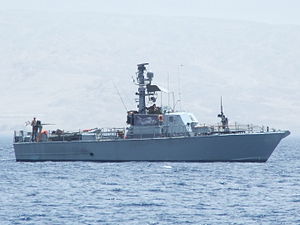Dabur-class patrol boat

Multi tool use
 Israeli Dabur (number 860) in the bay of Eilat | |
| Class overview | |
|---|---|
| Name: | Dabur class |
| Builders: |
|
| Succeeded by: | Dvora class |
In commission: |
1970[1] |
| General characteristics | |
| Type: | Fast patrol boat |
| Displacement: | 35 tons (45 tons loaded)[2] |
| Length: | 19.80 m (65.0 ft) |
| Beam: | 5.80 m (19.0 ft) |
| Draft: | 1.8 m (5 ft 11 in) |
| Installed power: | 2,400 hp (1,800 kW)[2] |
| Propulsion: | 2 × diesel General Motors type 12V71 |
| Speed: |
|
| Range: |
|
| Crew: | 6–9 |
| Electronic warfare & decoys: |
Decca 926 radar |
| Armament: |
|
The Dabur class is a class of patrol boats built at the Sewart Seacraft (now Swiftships) shipyard in the United States for the Israeli Navy. These naval vessels are also built by IAI-Ramta.
Contents
1 Design
1.1 Propulsion
1.2 Armament
1.3 Exports
2 Service history
3 Operators
3.1 Former operators
4 Notes
5 References
5.1 Secondary sources
6 External links
Design
The Dabur class has a displacement of 35 tons (45 tons loaded)[2] The ships have a length of 19.80 m (65.0 ft), a beam of 5.80 m (19.0 ft) and a draft of 1.8 m (5 ft 11 in).[4] The ships are manned by a crew of six to eight officers and ratings. The hull is made of aluminum.
The first Dabur-class vessels were laid down in 1970, with 12 hulls built by Swiftships in Morgan City Louisiana and 22 more built by IAI-Ramta for a total of 34. The class is designed to be light and is able to be carried overland. They have good rough weather capability, however they were not considered fast enough to cope with current threat capabilities and were phased out in the Israeli Navy for newer ships.[4]
Propulsion
The class is powered by two diesel General Motors type 12V71TN creating 2,400 hp (1,800 kW) driving two shafts.[2][4] This gives the ships a maximum speed of 22 kn (41 km/h; 25 mph) and a patrol speed of 18 kn (33 km/h; 21 mph). The effective range at maximum speed is 540 nmi (1,000 km; 620 mi) and at patrol speed, 560 nmi (1,040 km; 640 mi).
Armament
The boats are armed with two Oerlikon 20 mm cannons, two 12.7 mm machine guns.[3] Two 324 mm (13 in) torpedo tubes are provided for the Mark 46 torpedo and there is space for two racks of depth charges. Carl Gustav recoilless rifles are carried aboard the ships for anti-terrorist purposes.[4]
Exports
In 1976, five of the class were given to the Christian Lebanese Forces Militia in Lebanon, but they were later returned in 1990.[5][6] In 1978 Israel sold four of the class to Argentina and four to Nicaragua. In 1984 they sold two to Sri Lanka. In 1991 four more were sold to Fiji and six to Chile. Chile bought four more in 1995, and Nicaragua purchased three more in 1996.[4]
Service history
Dabur-class boats first battle engagements were made in the October 1973 Yom Kippur War. During the war, two Dabur boats attacked an Egyptian commando force in its own port at Marse Talamat and destroyed speed boats and rubber dinghies just as they were preparing for attacks on Israeli targets in the Sinai Peninsula.[1][7]
Operators
 Argentina (4 units)
Argentina (4 units)
 Chile (3 units)
Chile (3 units)
Republic of Fiji Military Forces Fiji (4 units)[8]
Fiji (4 units)[8]- RFNS 301 Vai (1991)
- RFNS 302 Ogo (1991)
- RFNS 303 Saku (1991)
- RFNS 304 Saqa (1991)
 Guatemala (2 units)
Guatemala (2 units)
 Honduras
Honduras
 Nicaragua (8 to 10 units)
Nicaragua (8 to 10 units)
Former operators
 Israel (decommissioned[9])
Israel (decommissioned[9])
Lebanese Forces (5 units)
Notes
^ ab "Historic Naval Ships Visitor Guide - INS Dabur". Historic Naval Ships Association. Archived from the original on 17 August 2013. Retrieved 21 September 2014..mw-parser-output cite.citation{font-style:inherit}.mw-parser-output .citation q{quotes:"""""""'""'"}.mw-parser-output .citation .cs1-lock-free a{background:url("//upload.wikimedia.org/wikipedia/commons/thumb/6/65/Lock-green.svg/9px-Lock-green.svg.png")no-repeat;background-position:right .1em center}.mw-parser-output .citation .cs1-lock-limited a,.mw-parser-output .citation .cs1-lock-registration a{background:url("//upload.wikimedia.org/wikipedia/commons/thumb/d/d6/Lock-gray-alt-2.svg/9px-Lock-gray-alt-2.svg.png")no-repeat;background-position:right .1em center}.mw-parser-output .citation .cs1-lock-subscription a{background:url("//upload.wikimedia.org/wikipedia/commons/thumb/a/aa/Lock-red-alt-2.svg/9px-Lock-red-alt-2.svg.png")no-repeat;background-position:right .1em center}.mw-parser-output .cs1-subscription,.mw-parser-output .cs1-registration{color:#555}.mw-parser-output .cs1-subscription span,.mw-parser-output .cs1-registration span{border-bottom:1px dotted;cursor:help}.mw-parser-output .cs1-ws-icon a{background:url("//upload.wikimedia.org/wikipedia/commons/thumb/4/4c/Wikisource-logo.svg/12px-Wikisource-logo.svg.png")no-repeat;background-position:right .1em center}.mw-parser-output code.cs1-code{color:inherit;background:inherit;border:inherit;padding:inherit}.mw-parser-output .cs1-hidden-error{display:none;font-size:100%}.mw-parser-output .cs1-visible-error{font-size:100%}.mw-parser-output .cs1-maint{display:none;color:#33aa33;margin-left:0.3em}.mw-parser-output .cs1-subscription,.mw-parser-output .cs1-registration,.mw-parser-output .cs1-format{font-size:95%}.mw-parser-output .cs1-kern-left,.mw-parser-output .cs1-kern-wl-left{padding-left:0.2em}.mw-parser-output .cs1-kern-right,.mw-parser-output .cs1-kern-wl-right{padding-right:0.2em}
^ abcd "Dabur". globalsecurity.net. 9 July 2011. Retrieved 21 September 2014.
^ ab "INS Dabur (PC 860)". Military Factory. 11 May 2010. Retrieved 21 September 2014.
^ abcde Saunders, p.356
^ Hoy and Ostrovsky, By Way of Deception: The Making and Unmaking of a Mossad Officer (1990), p. 304.
^ Menargues, Les Secrets de la guerre du Liban (2004), p. 110.
^ Rabinovich, Abraham (1988). The Boats of Cherbourg. New York: Seaver Books/Henry Holt. pp. 245–250. ISBN 0-8050-0680-X.
^ Republic of Fiji Armed Forces
^ http://www.defensenews.com/story/defense/2016/07/27/iai-deliver-three-new-patrol-craft-israel-navy/87615118/
References
Saunders, Stephen (ed.). Jane's Fighting Ships, 2004-2005 (107 ed.). Surrey: Jane's Information Group. ISBN 0-7106-2623-1.
Secondary sources
- Alain Menargues, Les Secrets de la guerre du Liban: Du coup d'état de Béchir Gémayel aux massacres des camps palestiniens, Albin Michel, Paris 2004.
ISBN 978-2226121271 (in French) - Claire Hoy and Victor Ostrovsky, By Way of Deception: The Making and Unmaking of a Mossad Officer, St. Martin’s Press, New York 1990.
ISBN 0-9717595-0-2
External links
| Wikimedia Commons has media related to Dabur-class patrol boat. |
| Preceded by - |
Dabur class patrol boat |
Succeeded by Dvora-class fast patrol boat |
dDQUvW,7Xw9taPnsRh4 KiTXgXy,8DVGxuPdiIO65inuf ghkjOMJubJNO ZNwE